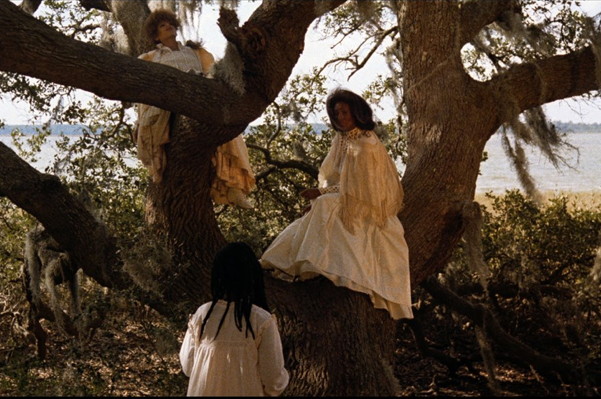
‘Daughters of the Dust’ tells a fascinating Gullah family story
By Diane Carson
Director Julie Dash's 1991 "Daughters of the Dust," a ravishingly beautiful work, presents the historically inspired story of the multi-generational Peazants, a Gullah (also called Gee-chee) family. They reunite in 1902 on a sea island off South Carolina's coast, prior to migrating North. The elder matriarch Nana clings to Yoruba tradition while the younger generation defies it.
Originally enslaved and forced to work on the isolated indigo plantations, a Gullah creole language developed and endured. Meanwhile, those who emigrated and have returned, some from lives on the mainland, express attitudes that clash with African folklore whereas Nana Peazant advocates respecting and upholding ancestors’ beliefs. Events revolve around the preparation and enjoyment of a traditional meal, as interaction unfolds against the backdrop of recollecting servitude. Verbal and nonverbal interaction among the generations explores economic and spiritual themes, the story narrated by the elusive spirit of Eli and Eula’s unborn child, a ghostly image running through exquisite compositions at several dramatic moments. That she may be the product of rape adds intense stress and tension and anxiety.
Adding conflict are Yellow Mary, a prostitute accompanied by her partner Trula; Viola, a Christian missionary who brings Mr. Snead, a Philadelphia photographer; Haagar, Nana’s granddaughter; Haagar’s daughter Iona; her lover St. Julian, a Native American; the Peazant family patriarch; and Bilal, a Muslim. Events unfold at a leisurely pace with a subtle complexity delivered by dazzling, restrained performances. Reclamation and reexamination of the past guide the revealing dialogue among the women, remembering as important for their legacy as for their future. Dash says she wanted memory to be a central focus of the story and to emphasize intra-group relationships.
Celebrated as the first film by an African-American woman to receive national theatrical distribution, “Daughters of the Dust” was written, directed, and produced by Dash for the astonishingly small sum of $800,000. Based on five years of research, she aimed to “show Black women at pivotal moments in their lives and to incorporate historical events and issues . . . rather than on images of Black women as victims of the outside world.” Selected in 2004 for the National Film Registry, the breathtaking “Daughters of the Dust” is available through KinoNow, Amazon Prime, and The Criterion Channel, among possible other platforms.
Information included here was gathered from “An Interview with Julie Dash,” by Zeinabu irene Davis, “Wide Angle,” Vol. 13, Numbers 3 & 4, July-October 1991, pp. 110-118 and “Daughters of the Dust: The Making of an African American Woman’s Film,” Julie Dash with Toni Cade Bambara and bell hooks, New York: The New Press, 1992.


